The Life and Times of Judge Roy Bean Blu-ray Movie
HomeThe Life and Times of Judge Roy Bean Blu-ray Movie 
Warner Bros. | 1972 | 123 min | Rated PG | Jul 17, 2018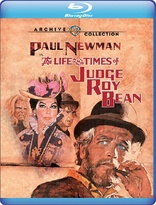
Movie rating
7 | / 10 |
Blu-ray rating
| Users | 4.0 | |
| Reviewer | 3.5 | |
| Overall | 3.5 |
Overview
The Life and Times of Judge Roy Bean (1972)
A no account outlaw establishes his own particular brand of law and order and builds a town on the edges of civilization in this farcical western. With the aid of an old law text and unpredictable notions Roy Bean distinguishes between lawbreakers and lawgivers by way of his pistols.
Starring: Paul Newman, Jacqueline Bisset, Tab Hunter, Stacy Keach, Roddy McDowallDirector: John Huston
| Western | Uncertain |
| Comedy | Uncertain |
| Romance | Uncertain |
Specifications
Video
Video codec: MPEG-4 AVC
Video resolution: 1080p
Aspect ratio: 1.78:1
Original aspect ratio: 1.85:1
Audio
English: DTS-HD Master Audio 2.0 Mono (48kHz, 24-bit)
Subtitles
English SDH
Discs
Blu-ray Disc
Single disc (1 BD)
Playback
Region A, B (C untested)
Review
Rating summary
| Movie | 2.5 | |
| Video | 4.5 | |
| Audio | 4.0 | |
| Extras | 0.5 | |
| Overall | 3.5 |
The Life and Times of Judge Roy Bean Blu-ray Movie Review
Pretty Boy Plays Reprobate
Reviewed by Michael Reuben August 4, 2018Judge Roy Bean was an actual historical figure, a bar owner and justice of the peace in Pecos
County, Texas. By all accounts, he was a colorful and corrupt public official, who styled himself
"the Law West of the Pecos", held court in his saloon and was known to fine offenders for
whatever money they had on them, which he kept for himself. (His reputation as a "hanging
judge" is a fictional embellishment.) He named one of his establishments "The Jersey Lily" in
honor of actress Lillie Langtry, whom he admired but never actually met. He was a hustler, an
entrepreneur and a scoundrel, and to screenwriter John Milius he was a figure of romantic
fascination. Milius compared him to Colonel T.E. Lawrence, a/k/a Lawrence of Arabia, and
declared: "That's the kind of people who built this country!"
Bean may not be as well known as Wyatt Earp or Billy the Kid, but he has appeared regularly in
Western tales. Walter Brennan won an Oscar for playing him in William Wyler's The Westerner.
Edgar Buchanan played him in a short-lived TV series from the Fifties entitled Judge Roy Bean.
Versions of him have appeared on TV in series as diverse as Death Valley
Days (in the Sixties),
Fantasy Island (in the Eighties) and Streets of Laredo (in the Nineties).
But in the Seventies, Bean was played on the big screen by Paul Newman in The Life and Times of Judge Roy Bean, directed by John
Huston from a screenplay by Milius. Although Milius was
routinely on the set, he appears to have been little more than a sounding board for Huston, who
had his own ideas about the film—and Milius hated the result, which he dismissed as "a movie
about Beverly Hills people". He particularly disliked the casting of Newman, who had snatched
the script away from Lee Marvin, to whom Milius originally sent it. The film was produced
through First Artists, the company Newman established with Sidney Poitier and Barbara
Streisand (later joined by Dustin Hoffman and Steve McQueen) in an attempt to replicate the
success of Chaplin, Pickford, Fairbanks and Griffith with United Artists. Production through
First Artists gave Newman a significant degree of control over the final product, while Milius
was relegated to the sidelines. The experience prompted him to become a director; so, if nothing
else, we can thank Judge Roy Bean for giving us The Wind and the Lion and Conan the Barbarian (among others).
Huston's Judge Roy Bean is an odd film, a Western cult classic with devoted fans (of which I am
not one). For those fans, or the merely curious, the Warner Archive Collection has added the film
to its Blu-ray catalog in a new transfer that captures the frontier dust and grit of this bizarre entry
in Paul Newman's filmography. (It was said to be one of his favorite roles.)
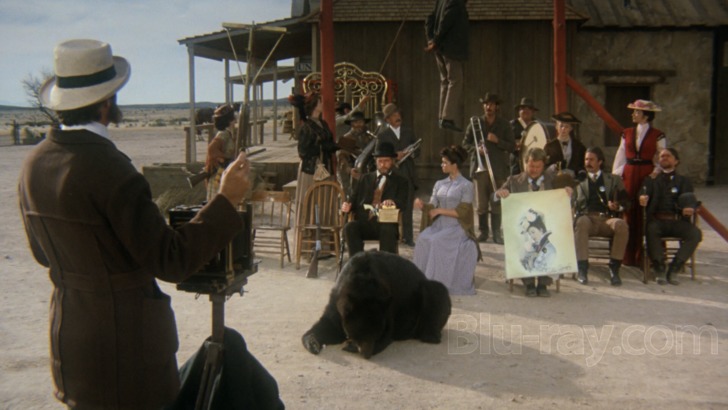
Huston opens the film with text screens establishing the locale and its lawless nature and declaring: "Maybe this isn't the way it was . . . it's the way it should have been . . ." Then Newman's Roy Bean rides into the West Texas town of Vinegaroon, where he is beaten by the locals and tied to his horse to be dragged into the wilderness with a noose around his neck. He's rescued by a Mexican orphan, Maria Elena, who will eventually become his live-in girlfriend. She's played by Victoria Principal, later of Dallas fame, in her film debut.
In the great tradition of movie tough guys, Bean recovers and returns to exact revenge on his attackers. Then he takes over the saloon where they savaged him and declares himself the law, equally loyal to the State of Texas and Miss Lillie Langtry, whose image on theatrical posters will multiply on the walls of Bean's establishment as his fortunes prosper. The face is that of actress Ava Gardner, who eventually makes an appearance, though not until the end of the film. (The spelling of "Lillie" varies throughout both history and Judge Roy Bean, but I'm following the version used on the posters adorning the Judge's tavern.)
Judge Roy Bean doesn't follow anything resembling the narrative arc of a conventional Western. It's a loosely episodic tale, whose tone shifts abruptly from farce to adventure to pathos—and back again. Characters appear out of nowhere and disappear just as quickly, beginning with Anthony Perkins' itinerant preacher, who helps Bean bury the bodies of his initial attackers, and then rides off to continue doing God's work. The preacher is one of the film's several narrators, all of whom provide essential exposition (including, in the preacher's case, his own death). Others include Roddy McDowall's squirrely lawyer named Frank Gass, who claims legal title to the land that Bean currently occupies, and Ned Beatty's Tector, who is one of the group of deputized "marshalls" that Bean gathers around him. (In other Westerns—e.g., Pale Rider—these supporting characters would be thugs with guns rather than the comic bumblers into which Huston makes them.) Stacy Keach appears in a single scene as an albino outlaw, "Bad Bob", whose braggadocio is no match for the Judge's wiliness, and Anthony Zerbe plays a San Antonio swindler that a clever fellow like Roy Bean should have seen through immediately. Huston himself appears in a cameo as Grizzly Adams, another historical figure whose legend spawned both a movie and a TV show. Bean's encounter with the mountain man leaves him the proud owner of a pet bear he initially names "Zachary Taylor" in honor of the nation's twelfth president (the one who died after just over a year in office). Late in the film, Jacqueline Bisset shows up as a character whose identity is best left for first-time viewers to discover on their own.
Huston even sticks a musical interlude into the film, no doubt inspired by Butch Cassidy and the Sundance Kid's sequence set to "Raindrops Keep Falling on My Head". Here the song is "Marmalade, Molasses and Honey", and it plays over scenes of the Judge picnicking with Maria Elena and the two of them riding a teeter-totter with "Zachary Taylor" on the other end. In a string of narrative incongruities, this sequence may be the most absurd, and screenwriter Milius singled it out for special contempt. (The song itself was the film's only Oscar nomination, but lost to "The Morning After" from The Poseidon Adventure.)
All the while, Bean continues to dispense his own form of frontier justice, hanging far more men than the real Judge Bean, and growing rich off the contents of their pockets. He is eventually undone by a combination of personal tragedy and Texas' transformation into the nation's oil capital. (Lawyer Frank Gass, whose name is prophetic, plays a key role in the latter.) Vinegaroon is built up, knocked down, rebuilt and destroyed anew. Throughout the proceedings, Newman takes obvious delight in playing the Judge's erratic behavior, casual brutality and assured pronouncements about whatever happens to be on his mind. His only soft spot is for Maria Elena, the one person to whom the Judge shows any consideration or tenderness. If Judge Roy Bean has an emotional center (and that's debatable), it belongs to Maria Elena.
The Life and Times of Judge Roy Bean Blu-ray Movie, Video Quality 
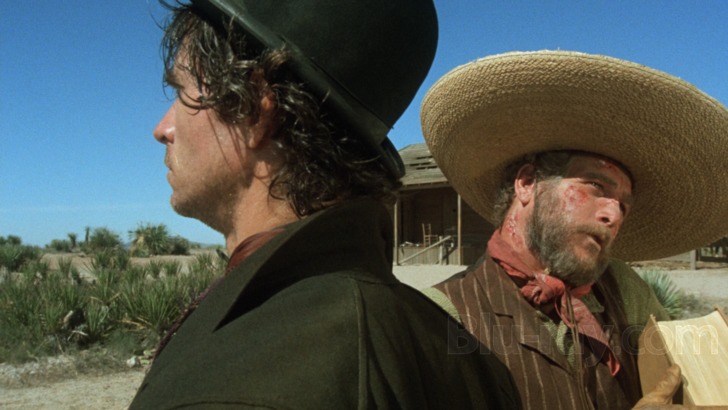
The Life and Times of Judge Roy Bean was shot by Richard Moore, a co-founder of Panavision,
whose work as a cinematographer grew out of his experience of manufacturing cameras for the
industry. He would reunite with John Huston ten years later for Annie
, after which he returned his
full attention to his increasingly influential camera company. Moore's lighting for Judge Roy
Bean, much of it shot on Arizona locations, runs the gamut from dim interiors to simulated
nights to bright sunlit exteriors. Shooting "flat" instead of in anamorphic widescreen, he was able to work
with less light and to compose with fewer concerns about distortion or depth of field.
For this 1080p, AVC-encoded Blu-ray, the Warner Archive Collection commissioned a new scan
of an interpositive, which was performed by Warner's MPI facility at 2K. Although the IP was of
recent vintage, it still reflected a significant accumulation of dirt and damage acquired by the
film's negative over the years. MPI used a Technicolor dye-transfer print as a reference for color-correction, and WAC subjected the master to
intensive cleaning to remove dirt and repair
scratches and other age-related flaws. As always on WAC's Blu-ray, the cleaning was performed
by hand, frame by frame; no automated process was employed.
The Blu-ray image is an excellent rendition of Judge Roy Bean's colorful frames, with a
gently film-like texture that captures fine detail in both foreground and background and a well-resolved reproduction of the film's natural grain
pattern. Rich earth tones predominate in this
(mostly) frontier setting, but they routinely contrast with colorful elements like the finery worn
by the town prostitutes and the even finer clothing acquired by a group that becomes
"respectable" (don't ask how). A brief side trip to San Antonio supplies a dramatic change in
palette, as well as an entirely new look for the title character on the rare occasion when he dresses
up. Black levels and contrast are accurate, although there may some of the familiar complaints
about "crush" because many of the interiors are dim and the film has a large number of scenes
shot "day for night", a process that reduces both contrast and detail. However, the Blu-ray
accurately reproduces the source as Huston and Moore shot it. WAC has authored the film at its
usual high average bitrate, here just a fraction under 35 Mbps.
The Life and Times of Judge Roy Bean Blu-ray Movie, Audio Quality 

Judge Roy Bean's mono soundtrack has been taken from the original magnetic master, which was in good shape and required only minimal cleanup. As usual with mono mixes, WAC has encoded the track in lossless DTS-HD MA 2.0. It's an effective audio accompaniment, reproducing dialogue clearly, along with an array of key sound effects. Dynamic range isn't noteworthy, but it's sufficiently effective for gunshots, as well as a number of explosions in a key sequence. Ironically, given the screenwriter's comparison of the title character to Lawrence of Arabia, the film was scored by the composer of David Lean's epic, Maurice Jarre, who did his best to adapt his musical accompaniment to Judge Roy Bean's abrupt tonal shifts.
The Life and Times of Judge Roy Bean Blu-ray Movie, Special Features and Extras 
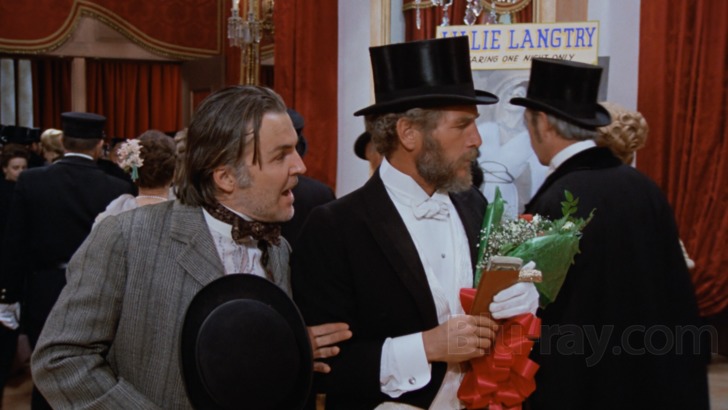
The only extra is a trailer, which has been remastered in 1080p. Warner's 2003 DVD was similarly bare.
The Life and Times of Judge Roy Bean Blu-ray Movie, Overall Score and Recommendation 
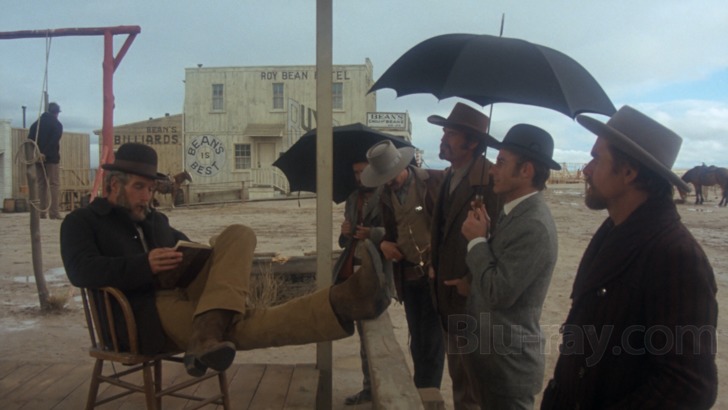
Paul Newman seemed to delight in roles that subverted his matinee idol image, and Judge Roy
Bean ranks high on the list of the actor's efforts to play against type. In his youth, even
Newman's disreputable characters were charming (like Hud or Fast Eddie Felsen), and it took
him a while to master the kind of off-putting eccentricities that finally began to gel in Robert
Altman's Buffalo Bill and the Indians, or Sitting Bull's History Lesson (1976). In Judge Roy
Bean, he always seems to be trying too hard, and Huston appears to have let him get away
with whatever he felt like doing on the day. (Then again, the director seems to have given
himself the same license.) Still, for those who appreciate the Judge, WAC has given him its usual
superior treatment on Blu-ray, which is recommended on its technical merits.
Similar titles
Similar titles you might also like

The Virginian
1946

Will Penny
1968

Rawhide
Desperate Siege
1951

Hombre
Limited Edition to 3000 - SOLD OUT
1967

The Ballad of Cable Hogue
Warner Archive Collection
1970

Cimarron
Warner Archive Collection
1960

Duel in the Sun
Roadshow Edition
1946

Alias Jesse James
1959

Shalako
1968

The Sons of Katie Elder
1965

Devil's Doorway
Warner Archive Collection
1950

McLintock!
Authentic Collector's Edition
1963

Warlock
Limited Edition to 3000
1959

Rio Grande
1950

The Fastest Gun Alive
Warner Archive Collection
1956

The Cimarron Kid
1952

Something Big
1971

Greaser's Palace
1972

Rough Night in Jericho
1967

The Paleface
1948